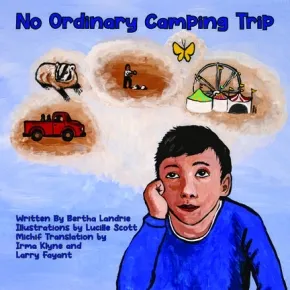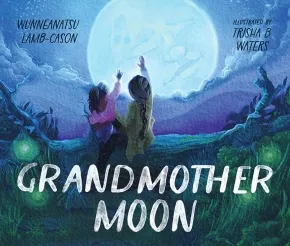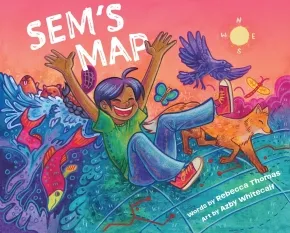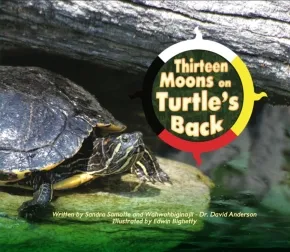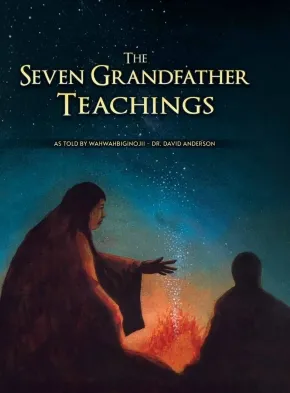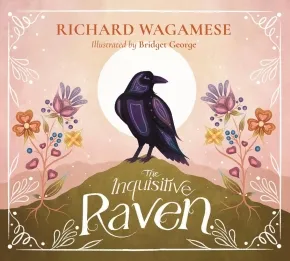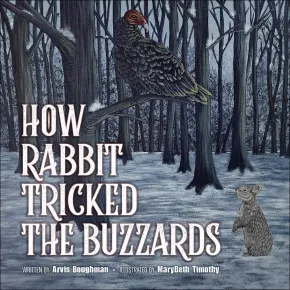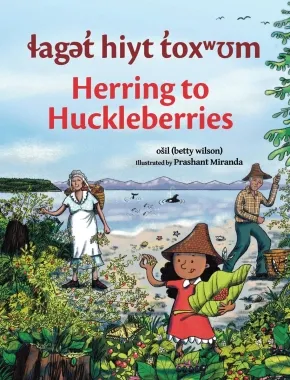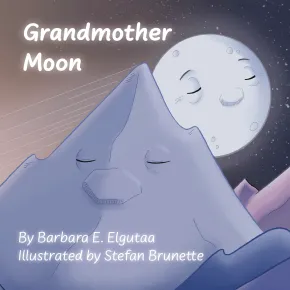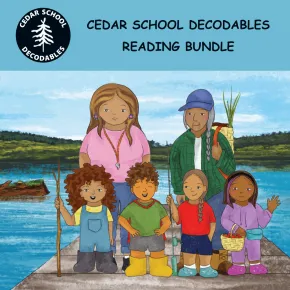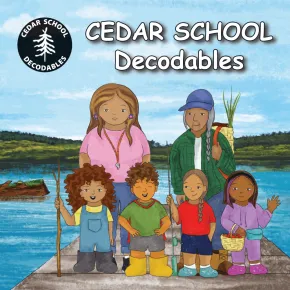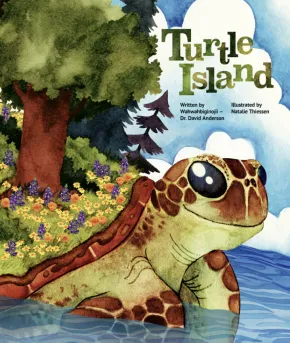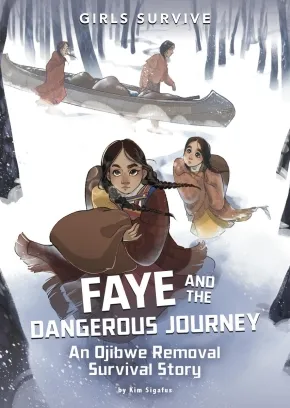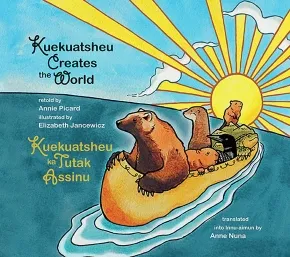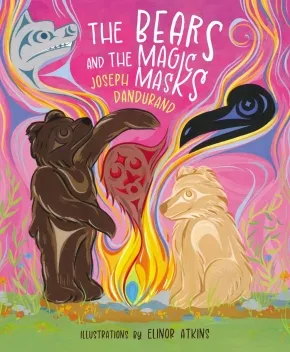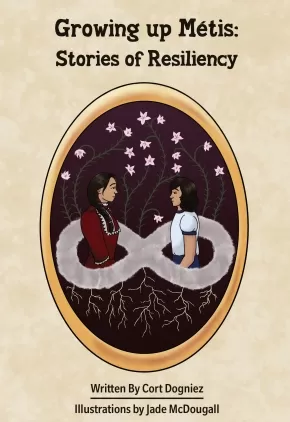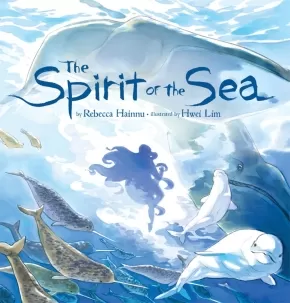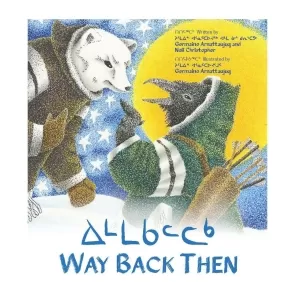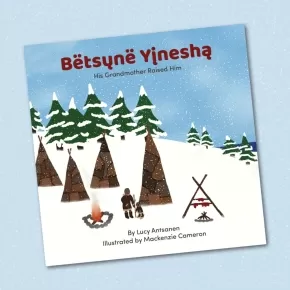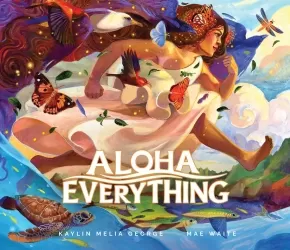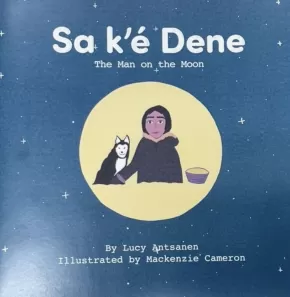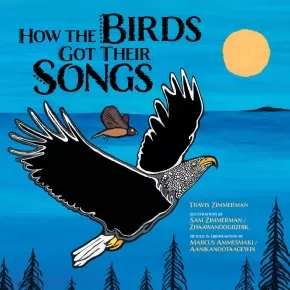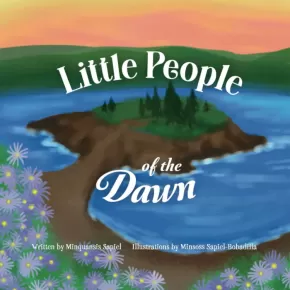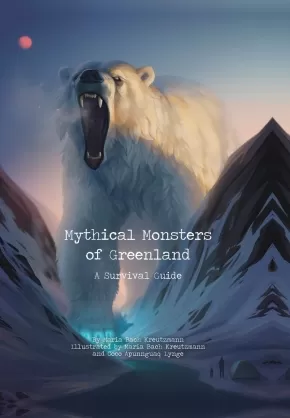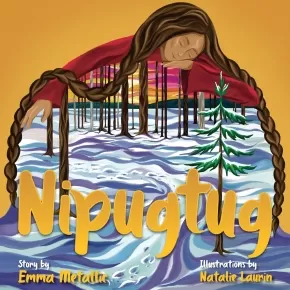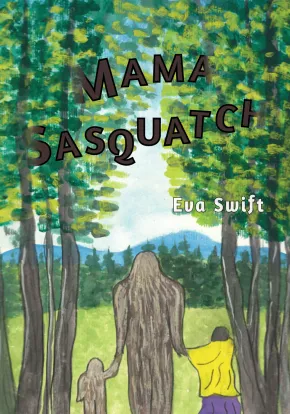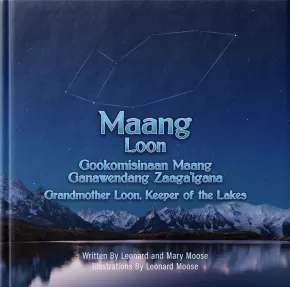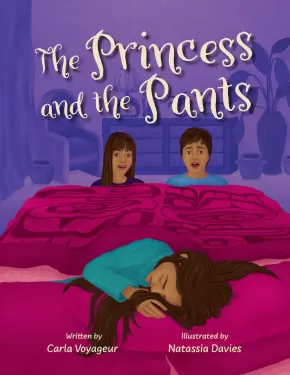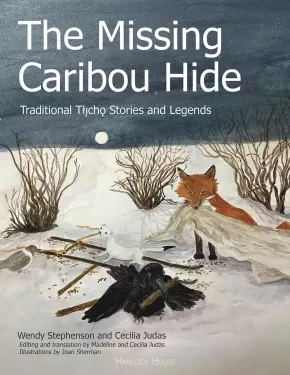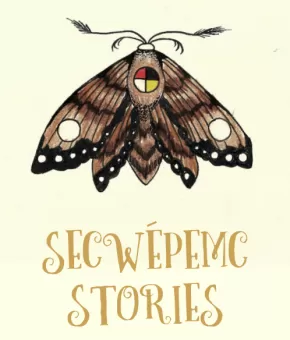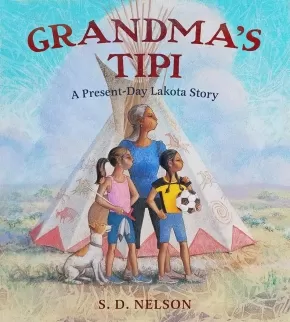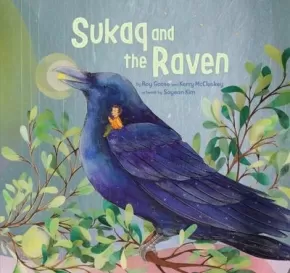
Indigenous Stories
1
-
15
of
247 Results;
Sort By
Go To
of 17
No Ordinary Camping Trip
$17.50
Artists:
Format:
Paperback
Text Content Territories:
Indigenous Canadian; Métis;
ISBN / Barcode: 9781988011363
Synopsis:
Synopsis:
In No Ordinary Camping Trip, Bertha Landrie recounts a tale from her husband, Joe’s, childhood. Many Métis families relied on seasonal employment, working for farmers, clearing fields, picking Seneca root, and other labour jobs to support themselves. In this coming-of-age story, a young Joe works hard picking rocks in order to make money to go to the North Battleford Fair. Will they be able to finish the job in time? Lucille Scott’s evocative illustrations take us back in time while capturing the story’s essence. Michif Old Ones, Irma Klyne and Larry Fayant provide a Southern Michif translation—the language of the Landrie family.
Reviews
"Rich in cultural detail, the story introduces young readers to aspects of Métis culture and values. The book celebrates themes of family, resilience, and identity. Suitable for grades three to five Social Studies and Language Arts, it supports curricular goals related to Indigenous perspectives, cultural diversity, and belonging, while promoting early bilingual literacy through its inclusion of Michif. Narrations in English and Michif are available through a link provided by the publisher, and supplementary information about the Road Allowance period in Métis history is also provided." - Bonny-Lynn D., Elementary School Teacher, Indigenous Books for Schools
Educator Information
Recommended for Grades 3 to 5.
Dual-language format: Michif and English.
Themes: Childhood; Coming of Age; Family; Intergenerational Roles
Additional Information
37 Pages | 9" x 9" | Paperback
A Collection of Lost Tails: & Other Animal Stories
$11.95
Format:
Paperback
Text Content Territories:
Indigenous;
ISBN / Barcode: 9781738736799
Synopsis:
Synopsis:
A long time ago, Robin wore a white breast, Rattlesnake didn't rattle, Rabbit and Bear both sported luscious, long tails, and the naked-necked Turkey Buzzard meant to be fully clothed. Witness how these animals were transformed into the ones we recognize today with these traditional tales re-told.
Educator Information
Recommended for Grades 6 and under.
Additional Information
45 pages | 4.25" x 5.50" | Paperback
Grandmother Moon
$25.99
Artists:
Format:
Hardcover
Text Content Territories:
Indigenous American; Native American; Schaghticoke;
ISBN / Barcode: 9781506487038
Synopsis:
Synopsis:
"Nohhum, doesn't it look like the moon is following us?"
During her weekly car ride with her grandmother from the city to the reservation, a young Native girl ponders the moon that seems to follow them. Each week, she looks forward to listening to her grandmother's warm, soothing voice as she sings and tells stories. Tonight, her grandmother teaches her about Grandmother Moon, her significance, and why we honor her.
In her debut picture book, Wunneanatsu Lamb-Cason (Schaghticoke/HoChunk) captures a grandmother and grandchild's relationship through their shared wonder and admiration. Along with rich illustrations, Grandmother Moon preserves Indigenous histories and teachings within a modern setting, reminding us that Grandmother Moon is always watching over us, and wherever we are, we are safe and loved.
Backmatter includes an author's note and more, to learn about the different names of the full moons throughout the lunar year.
Reviews
"A beautiful glimpse into Native storytelling traditions and intergenerational family ties.... VERDICT A solid choice for libraries needing books on Indigenous populations or looking for an introduction to Native belief systems." --School Library Journal
Educator Information
Recommended for ages 4 to 8.
Themes, Subjects & Keywords: Moon, Family, Giving Thanks - Tobacco Offerings, Thirteen Moons on Turtle's Back, Lunar Calendar, Importance of Stories - Storytelling.
Additional Information
32 pages | 10.25" x 8.75" | Hardcover
Sem's Map
$14.95
Artists:
Format:
Paperback
Text Content Territories:
Indigenous Canadian; First Nations; Mi'kmaq (Mi'gmaq);
ISBN / Barcode: 9781774714966
Synopsis:
Synopsis:
From the author of I'm Finding My Talk comes a candid picture book about the importance of Indigenous place names, and acknowledging traditional lands.
Sem is confused. The map Mr. Trainer has just put on the screen is all wrong. It's the same shape as Turtle Island but it's nothing but boxes and lines, and it's filled with names he doesn't know. There's no reference to the stories of the land his Kiju tells him every night while she braids his hair. But Sem's teacher and classmates claim there's nothing wrong. It's the same map they've always used.
See tries to see the land the way Mr. Trainer showed him, but it just doesn't feel right. Where is the story of how the moose gets his dinner? Or where the fish run in the spring? Or when to tap the trees for syrup?
With the help of Kiju, Sem will show his teacher and his classmates how the stories of the land, the Indigenous place names, are far older than any map.
A gentle calling-in, this assured story from Governor General's Award finalist Rebecca Thomas is paired with colourful, lively illustrations from Azby Whitecalf, as well as colonial and decolonial maps of Turtle Island (North America) for reference. Sem's Map is an invaluable resource for caregivers, educators, and young readers about the importance of acknowledging the traditional lands we live on, and unlearning colonial ways of the past.
Educator Information
Recommended for ages 5 to 9.
Themes / Subjects: First Nations, Indigenous Knowledge, place names, land acknowledgement, decolonization, history, social studies
Additional Information
32 pages | 10.00" x 8.00" | Paperback
Celebrating Potlatches
$21.95
Artists:
Format:
Hardcover
Text Content Territories:
Indigenous Canadian; First Nations; Tsimshian (Ts'msyen); Nisga'a;
ISBN / Barcode: 9781771746564
Synopsis:
Synopsis:
“Papa, what is a Potlatch?”
Inspired by Ts’msyen Chief William Beynon’s historic notebooks on Potlatches in the Gitxsan village of Gitsegukla, Celebrating Potlatches pairs intergenerational storytelling with beautiful illustrations to honour Indigenous traditions. From the award-winning author of Oolichan Moon and the accomplished illustrator of Be a Good Ancestor, this book recounts the 1885 Potlatch ban and the resilience of the communities who fought to keep their traditions alive.
Reviews
“Heartfelt and timely, Celebrating Potlatches gifts readers with cultural teachings through an intergenerational account of Indigenous resilience. This book is a beautiful tribute to the author’s great-grandfather, William Beynon, whose life’s work documenting oral histories of Sm’algya̱x-speaking Peoples and their Potlatches continues to be foundational to our cultural resurgence today.” – Sm Łoodm ‘Nüüsm (Dr. Mique’l Dangeli), Sm’algya̱x language expert and Assistant Professor of Indigenous Arts at the University of Victoria
“This beautiful book shares the importance of community, culture, and identity. As you make your way through the pictures and words, they bring you to an understanding of how important the Potlatch ceremony was and continues to be for Indigenous Peoples.” – Carolyn Roberts, educator, speaker, and author of Re-Storying Education
Educator Information
Recommended for ages 4 to 8.
Through this conversational historic account, readers can learn alongside the narrator as his Papa shares his wisdom about the rich history of the Potlatch.
Curriculum Connections
- Early literacy – listening, reading, and discussing
- Art – traditional Indigenous art, drumming, and regalia
- Social studies – the 1885 Potlatch ban, history of Indigenous Peoples, connection to community
- Social responsibility – uplifting ourselves and others, honouring traditions
- Indigenous knowledge and traditions – traditional teachings, Potlatch ceremonies, intergenerational storytelling
Two free, downloadable lesson plans—one for kindergarten to Grade 1 and one for Grades 2 to 3—provide connections to Social Studies curriculum.
Additional Information
32 Pages | 10" x 8.5" | Hardcover
Thirteen Moons on Turtle's Back
$19.95
Format:
Hardcover
Text Content Territories:
Indigenous Canadian;
Grade Levels: 1;
ISBN / Barcode: 9781990297908
Synopsis:
Synopsis:
Learn about the Thirteen Moons on Turtle's Back with this easy to read beautifully illustrated rhyming book. A great tool to help young children understand and learn the many teachings of the thirteen Moons on Turtle's Back.
Educator Information
Recommended for Grade 1 students.
Additional Information
Hardcover
The Seven Grandfather Teachings
$19.95
Format:
Hardcover
Text Content Territories:
Indigenous Canadian; First Nations; Anishinaabeg;
ISBN / Barcode: 9781779510051
Synopsis:
Synopsis:
There was a time when the Anishinaabeg (Human Beings) were not living together in balance and in Harmony with Mother Earth or with one another.
The Seven Grandfathers asked their Oshkaabewis (Helper/Messenger), to find someone to carry their Teachings. Oshkaabewis met Little Boy and introduced him to The Seven Grandfathers who welcomed Little Boy and shared their Gifts with him. These Gifts are now known and called The Seven Grandfather Teachings.
Educator Information
Recommended for grades 4 to 6.
Additional Information
24 Pages | Hardcover
The First Peoples
$22.95
Artists:
Text Content Territories:
Indigenous Canadian; Inuit;
ISBN / Barcode: 9781772275650
Synopsis:
Synopsis:
Based on an ancient Inuit traditional story, this beautifully illustrated picture book tells of the appearance of the first humans on earth, and how from them all the peoples of the earth emerged. From a mound of simple dirt, through magic and intention, the world we know today slowly takes shape across the page.
Retold with loving care by Inuit author and actress Maika Harper, The First Peoples is both mythical and magical, an ancient tale brought to life for new generations.
Educator Information
Recommended for ages 6 to 8.
Additional Information
24 pages | 8.50" x 9.50" | Hardcover
The Inquisitive Raven
$24.95
Format:
Hardcover
Text Content Territories:
Indigenous Canadian; First Nations; Anishinaabeg; Ojibway;
ISBN / Barcode: 9781771624497
Synopsis:
Synopsis:
Share in a raven’s sense of wonder as this gorgeous picture book brings Richard Wagamese’s wisdom to young audiences.
“Reuben was an inquisitive raven. Of course, all ravens are inquisitive, but Reuben was a notch above even the most curious bird.” So begins a story by beloved author Richard Wagamese, about a raven that has the whole forest talking. Some think he is nosy, but really, he is in a state of utter amazement at the world. He suggests new designs for the beavers’ dams, imitates the blue herons’ one-legged stance as they spear minnows, and squawks in glee at the sight of the bears emerging from hibernation. When he sees an eagle soaring high in the sky, he tries to soar just as high, in order to earn the other animals’ respect—only to learn that respect is not something one earns, but something one carries.
This book is yet another example from Richard Wagamese about the power of storytelling. Beautifully illustrated with original work from Anishinaabe artist Bridget George, The Inquisitive Raven is sure to be cherished by readers of all ages.
Educator & Series Information
Recommended for ages 6 to 8.
This book is part of the Richard Wagamese Storybook Collection.
Additional Information
32 pages | 10.25" x 9.25" | Hardcover
Askemawso
$14.95
Format:
Paperback
ISBN / Barcode: 9781998223305
Synopsis:
Synopsis:
The story follows a wəlastəkewi skitap (man) named Askəmawsit along with his friends, Mahtəkwehs and Kahkakohs. It is the story of his quest of finding long lost Kelowəskap, in hopes that he can grant Askəmawsit’s biggest wish to live forever.
Educator Information
Recommended for ages 5 to 8.
Additional Information
36 pages | 9.25" x 7.25" | Paperback
How Rabbit Tricked the Buzzards
$18.95
Artists:
Format:
Paperback
Text Content Territories:
Indigenous American; Native American; Lumbee;
ISBN / Barcode: 9781570674259
Synopsis:
Synopsis:
Long ago, when the buzzards were keepers of the fire, they were very stingy. On a frigid winter night Rabbit was freezing, he pleaded with the buzzards to share the warmth of their fire. The buzzards refused, yelling "This is our fire!" The playful Northwest Wind saw rabbit hopping slowly away, it decided to play tricks on Rabbit to make him even colder. Rabbit realized that If he wanted to get warm, and share the warmth with the other animals, he must come up with a clever plan.
Educator Information
Recommended for Grades 2 and under.
Additional Information
40 pages | 9.00" x 9.00" | Paperback
laget hiyt toxwum / Herring to Huckleberries
$24.95
Artists:
Format:
Hardcover
Text Content Territories:
Indigenous Canadian; First Nations; Salish; Coast Salish; Tla'amin (Sliammon);
ISBN / Barcode: 9781774921180
Synopsis:
Synopsis:
Join ošil and her grandparents as they harvest food along what is now called the southwest coast of British Columbia!
It’s ošil’s favourite time of year! When the seasons change and the weather grows warm, the ɬagət̓ (herring) return to the waters of the ɬaʔəmɩn Nation, located on the southwest coast of British Columbia. For ošil and her grandparents, their arrival is the beginning of a full year of harvesting traditional foods provided by the sea and land. Together they fish, pick berries, and dig for clams. Everything tastes so good. And the best part is that there is enough for everyone to share!
Connect with the land and explore traditional Indigenous ways of gathering food in this beautifully illustrated picture book written in the language spoken in Tla’amin and English. Drawn from the childhood memories of ošil (betty wilson), this book is sure to charm readers of all ages.
Reviews
“I absolutely loved this story. [It] gives readers the opportunity to experience life through the main character's eyes as she harvests traditional foods with her grandparents.The colourful images and descriptions—of herring roe, fish soup, and mashed fresh harvested berries with oven bread—are wonderful and made me wish for all these delicacies.”—Nicola I. Campbell, author of Stand Like a Cedar
“Prashant Miranda's expressive illustrations bring ošil’s story of ɬaʔəmɩn lands, language, and food to life. Whether this is an introduction to ʔayʔajuθəm or a warm trip down memory lane, as it was for me, this book will be enjoyed by readers of all ages.”—Cameron Fraser-Monroe, dancer and choreographer (Royal Winnipeg Ballet)
Educator Information
Recommended for ages 6 to 8.
Explore this captivating story that bridges generations, celebrates cultural practices, and immerses readers in the rich traditions of the Tla’amin Nation.
Connect with the land and explore traditional Indigenous ways of gathering food in this beautifully illustrated picture book written in the language spoken in ʔayʔajuθəm and English.
Dual-Language: written in the language spoken in Tla'min and English.
The backmatter includes information on traditional foods in Tla'amin, a glossary, a note from the author, and a map.
Big Ideas: Land-Based or Place-Based Learning, Aspects of Indigenous Cultures: Traditional Foods, STEM: Seasonal Cycles, STEM: Environmental Stewardship and Sustainability.
Additional Information
44 pages | 7.75" x 10.25" | Hardcover
Grandmother Moon
$16.95
Artists:
Format:
Hardcover
Text Content Territories:
Indigenous American; Native American; Haudenosaunee (Iroquois); Oneida (Onyota'a:ka);
ISBN / Barcode: 9781068868627
Synopsis:
Synopsis:
Grandmother Moon is lonely in the night sky. When she stops in her journey to hear Brother Mountain's stories, she also stops the sun from rising, the animals from sleeping, and more! This causes the Creator to intervene, but how can Grandmother Moon's loneliness be solved while ensuring the sky moves from night to day?
Educator Information
Recommended for grades 3 and under.
Additional Information
36 Pages | 8.25" x 8.25" | Hardcover
Cedar School Decodables - Reading Bundle
 $958.80
$958.80

Grade Levels: Kindergarten; 1;
ISBN / Barcode: 9781771746571
Synopsis:
Synopsis:
Welcome to Cedar School! Join Liv, Tom, Gus, and Bell as they learn on the land and explore Mi’gmaw teachings with their teacher, Miss Sam, and the school’s Mi’gmaw Elder, Jen. With charming illustrations and simple storylines, this decodable series engages students as they practise their reading skills. Each book includes a pre-reading review of non-decodable words, and many of the books introduce special words related to Indigenous teachings. Talking Together prompts facilitate discussions led by the reading teacher.
Developed in partnership with Dyslexia Canada, Cedar School Decodables is a series of 20 decodable books for young readers. Designed for students who have previously learned short vowel and consonant sounds, additional phonic skills are developed progressively throughout the series. Cedar School Decodables is divided into six sets, which increase in word count and complexity of sentence structure:
Set 1 – Short Vowels (40-60 words)
Set 2 – Digraphs (60-80 words)
Set 3 – VCe (80-90 words)
Set 4 – Longer Words (90-100 words)
Set 5 – Ending Spelling Patterns (100-110 words)
Set 6 – R-Controlled Vowels (110-125 words)
Educator Information
This bundle includes 120 books: six copies each of the 20 Cedar School Decodables titles. The Cedar School Decodables Teacher’s Guide, which will be available for purchase at a later date, is not included in this bundle.
This series is recommended for ages 4 to 7 for use in kindergarten and Grade 1 classrooms.
Additional Information
Each book is 16 pages | 6.5” x 5.5” | Paperback | Reading Bundle ISBN: 9781771746571
Cedar School Decodables: The Star World
 $7.99
$7.99

Artists:
Format:
Paperback
Text Content Territories:
Indigenous Canadian; First Nations; Mi'kmaq (Mi'gmaq); Listuguj Mi'gmaq First Nation;
Grade Levels: Kindergarten; 1;
ISBN / Barcode: 9781771746533
Synopsis:
Synopsis:
In this story, Jen shares a Mi’gmaw Creation Story. It explains how Mi’gmaq grew from the earth.
Mi’gmaq pass down knowledge and teachings through storytelling. Some stories are written with pictures instead of words. These pictures are called hieroglyphs.
Can you find the hieroglyph that means “lightning” in the book?
Educator Information
Recommended for ages 4-7, for use in kindergarten and Grade 1 classrooms.
Cedar School Decodables is divided into six sets, which increase in word count and complexity of sentence structure. The Star World is in Set 6 – R-Controlled Vowels, and reviews ar, or, and ore. Books in Set 6 have 110-125 words.
Readers should be familiar with the concepts included in Set 1 to Set 6:
- consonants
- beginning and end blends
- short, long, and r-controlled vowels
- digraphs
- suffixes and ending spelling patterns
- a /o/
- s – /s/ and /z/
- VC-CV, V/CV, VC/V, and compound words
- possessives
Series Information
Welcome to Cedar School! Join Liv, Tom, Gus, and Bell as they learn on the land and explore Mi’gmaw teachings with their teacher, Miss Sam, and the school’s Mi’gmaw Elder, Jen. With charming illustrations and simple storylines, this decodable series engages students as they practise their reading skills. Each book includes a pre-reading review of non-decodable words, and many of the books introduce special words related to Indigenous teachings. Talking Together prompts facilitate discussions led by the reading teacher.
Developed in partnership with Dyslexia Canada, Cedar School Decodables is a series of 20 decodable books for young readers. Designed for students who have previously learned short vowel and consonant sounds, additional phonic skills are developed progressively throughout the series.
The series will be accompanied by Cedar School Decodables Teacher’s Guide and a series of four picture books, which will be available at a later date.
Additional Information
16 pages | 6.5” x 5.5” | Paperback | ISBN: 9781771746533
Cedar School Decodables - Series Bundle
 $159.80
$159.80

Text Content Territories:
Indigenous Canadian; First Nations; Mi'kmaq (Mi'gmaq); Listuguj Mi'gmaq First Nation;
Grade Levels: Kindergarten; 1;
ISBN / Barcode: 9781771746557
Synopsis:
Synopsis:
Welcome to Cedar School! Join Liv, Tom, Gus, and Bell as they learn on the land and explore Mi’gmaw teachings with their teacher, Miss Sam, and the school’s Mi’gmaw Elder, Jen. With charming illustrations and simple storylines, this decodable series engages students as they practise their reading skills. Each book includes a pre-reading review of non-decodable words, and many of the books introduce special words related to Indigenous teachings. Talking Together prompts facilitate discussions led by the reading teacher.
Developed in partnership with Dyslexia Canada, Cedar School Decodables is a series of 20 decodable books for young readers. Designed for students who have previously learned short vowel and consonant sounds, additional phonic skills are developed progressively throughout the series. Cedar School Decodables is divided into six sets, which increase in word count and complexity of sentence structure:
Set 1 – Short Vowels (40-60 words)
Set 2 – Digraphs (60-80 words)
Set 3 – VCe (80-90 words)
Set 4 – Longer Words (90-100 words)
Set 5 – Ending Spelling Patterns (100-110 words)
Set 6 – R-Controlled Vowels (110-125 words)
Educator Information
This bundle includes 20 books: one copy each of the 20 Cedar School Decodables titles. The Cedar School Decodables Teacher’s Guide, which will be available for purchase at a later date, is not included in this bundle.
This series is recommended for ages 4 to 7 for use in kindergarten and Grade 1 classrooms.
Additional Information
Each book is 16 pages | 6.5” x 5.5” | Paperback | Series ISBN: 9781771746557
Turtle Island
$19.95
Artists:
Format:
Hardcover
Text Content Territories:
Indigenous Canadian;
ISBN / Barcode: 9781779550026
Synopsis:
Synopsis:
This is one Creation Story of how some of Our Relatives, The Swimmers and The Winged-Ones helped Creator make Land for The Two-Legged, The Four-Legged, and The Crawlers on Turtle Island.
Additional Information
27 Pages | Hardcover
Faye and the Dangerous Journey: An Ojibwe Removal Survival Story
$13.99
Artists:
Format:
Paperback
Text Content Territories:
Indigenous American; Native American; Anishinaabeg; Ojibwe (Chippewa);
ISBN / Barcode: 9781669086239
Synopsis:
Synopsis:
In the fall of 1850, Faye and her family begin a long, difficult journey with thousands of other Ojibwe people to receive money the U.S. government owes them. But why isn’t the money being delivered to them in Wisconsin, as usual? Why must they walk and canoe all the way to the middle of Minnesota in terrible weather? These are questions Faye asks, but the answers don’t make sense. When her family reaches their destination, Mama is sick, and there is no money as promised. Will Faye and her family make it back home? Will there be a home to return to? In this gripping story with nonfiction backmatter—including an author’s note, discussion questions, and more—readers will learn about the traumatic events of the Sandy Lake Ojibwe removal in this Girls Survive historical fiction.
Educator Information
Recommended for ages 8 to 12.
Additional Information
112 pages | 5.25" x 7.50" | Paperback
Kuekuatsheu Creates the World / Kuekuatsheu ka Tutak Assinu: (Sheshatshiu dialect)
$24.99
Artists:
Format:
Hardcover
ISBN / Barcode: 9781998802203
Synopsis:
Synopsis:
The story of how the world came to be on the turtle's back can be found in Indigenous cultures throughout North America/Turtle Island. It has many variations. This moving version of the tale—a story of resilience, sacrifice, and friendship—is one that Annie Picard was often told as a child by her maternal grandmother while they lived in nutshimit (on the land) in the Labrador/Quebec peninsula. Picard's lovely re-telling of this traditional Innu story of how little muskrat makes an enormous sacrifice to help the wolverine and his other friends rebuild the world after a great flood is brought vividly to life by Elizabeth Jancewicz's stunning illustrations.
Educator Information
Recommended for ages 4 to 8.
Bilingual: English and Innu-aimun.
Translation into Innu-aimun by Anne Nuna.
Additional Information
36 Pages | 9" x 8" | Hardcover | 2nd Edition
The Bears and the Magic Masks
$15.95
Artists:
Format:
Paperback
Text Content Territories:
Indigenous Canadian; First Nations; Salish; Coast Salish; Sto:lo; Kwantlen;
ISBN / Barcode: 9780889714748
Synopsis:
Synopsis:
Award-winning storyteller and poet Joseph Dandurand captures the delightful relationship between bears and the Kwantlen people in his fourth book for children ages 6–8.
For a long time, the Kwantlen and the bears have lived side by side. When the master carver falls into the river, the bears rescue him. In thanks, the master carver gives the bears animal masks. But the bears don’t know that these masks are magical.
The Bears and the Magic Masks is the fourth in the Kwantlen Stories Then and Now series by award-winning author Joseph Dandurand, following The Girl Who Loved the Birds, A Magical Sturgeon and The Sasquatch, the Fire and the Cedar Baskets.
Educator & Series Information
Recommended for ages 6 to 8.
This is the fourth book in a series of Kwantlen legends, the Kwantlen Stories Then and Now series, by award-winning author Joseph Dandurand.
Additional Information
32 pages | 7.00" x 8.50" | Paperback
Growing up Métis : Stories of Resiliency
$17.50
Artists:
Format:
Paperback
Text Content Territories:
Indigenous Canadian; Métis;
ISBN / Barcode: 978-1-988011-34-9
Synopsis:
Synopsis:
Cort Dogniez’s Growing up Métis: Stories of Resiliency is the second installment of his historical fiction series that began with Road to La Prairie Ronde. In two separate, but connected fictionalized stories, Cort delves into the lives of two of his foremothers: his great-grandmother, Josephine Gariepy and his grandmother, Clara Dumont when they were young. While highlighting the dispossession and marginalization of his ancestors following the 1885 Resistance, Cort deftly weaves Métis culture through these two stories with a positive “focus on nicknames, faith, storytelling, and a resilient spirit.”
Jade McDougall’s beautiful illustrations brings these poignant, coming of age stories to life. Growing up Métis: Stories of Resiliency includes Michif and Cree glossaries to reflect Josephine and Clara’s first languages as well as guide questions for educators to explore the stories and Métis culture in depth with their students.
Educator & Series Information
Recommended by the publisher for ages 9+.
This book is the second installment in the historical fiction series that began with Road to La Prairie Ronde.
Additional Information
85 Pages | 14 cm x 20.3 cm | Paperback
Dad, I Miss You
$22.95
Artists:
Format:
Hardcover
Text Content Territories:
Indigenous Canadian; Inuit;
ISBN / Barcode: 9781772274820
Synopsis:
Synopsis:
Told in the voice of a boy and his father by turns, this book takes a thoughtful and heartfelt look at the emotional toll of a child being taken from their family and community to attend residential school.
While the child’s internal monologue expresses his fear, confusion, and loss, the father’s monologue conveys his own sadness, fears, and hopes for the future of his child. The narrative gives voice to the things left unsaid between a parent and child experiencing this heart-rending separation. Upon his return to his community, when father and son are reunited, they must start the long process of reconnection.
Based on the author’s family history of residential school separation, this book provides a unique perspective on the difficult cycle of loss, reconnection, and regaining hope for the future.
Educator Information
Recommended for ages 9 to 12.
Additional Infroamtion
40 pages | 9.00" x 8.00" | Hardcover
The Spirit of the Sea (PB)
$14.95
Artists:
● Hwei Lim
Format:
Paperback
Text Content Territories:
Indigenous Canadian; Inuit;
ISBN / Barcode: 9781772275216
Synopsis:
Synopsis:
This beautifully illustrated picture books tells the story of the spirit of the sea, referred to as Nuliajuq, Sedna, Takannaaluk, and many other Inuktitut names.
Once a young woman who refused to marry, the lies and deceit of a treacherous bird—and her own father's cowardice—lead Nuliajuq to a life of solitude at the bottom of the ocean as the powerful, at times vengeful, spirit of the sea.
The Spirit of the Sea provides young readers with an authentic retelling of one of the most important, powerful legends in the canon of Inuit traditional stories.
Reviews
"The text, which is appropriate for upper elementary readers and above, is meant to be read aloud and generally has the sound of a traditional storyteller’s voice. The watercolours by Hwei Lim are beautiful and ethereal. The Spirit of the Sea is highly recommended for elementary school libraries, public libraries and libraries specializing in Canadian Indigenous materials."—Deakin Review
"The Spirit of the Sea would be great for reading aloud [and] independent reading."—Canadian Teacher
Educator Information
Recommended for ages 6 to 8.
Additional Information
32 pages | 8.75" x 8.75" | Paperback
Way Back Then (PB)
$16.95
Artists:
Format:
Paperback
Text Content Territories:
Indigenous Canadian; Inuit;
ISBN / Barcode: 9781772270211
Synopsis:
Synopsis:
Kudlu's children will not go to sleep until he tells them a story of long ago. Before they will shut their eyes, they want to hear about a time long before Kudlu was born, a time when the world was magic. Before they can sleep, they want to hear about giants, animals disguised as humans, little people the size of lemmings, and all of the other wonderful things that existed way back then.
Educator Information
Recommended for ages 6 to 8.
Bilingual: English and Inuktitut
Reviews
“A bilingual sampler—cold of setting but warm of spirit.” — ★ Kirkus
Additional Information
44 pages | 8.75" x 8.75" | Paperback
Bёtsųnё Yįneshą: His Grandmother Raised Him
$6.00
Artists:
Format:
Paperback
Text Content Territories:
Indigenous Canadian; First Nations; Dene; Denesuline (Chipewyan);
Reading Level: N/A
ISBN / Barcode: PC168
Synopsis:
Synopsis:
Long ago, some Dene girls playing outside in the wintertime were perplexed about the cries of a baby when all they spotted was caribou droppings. A grandmother called to assist hears the baby and makes a startling discovery that changes the life of both herself and the baby.
Educator Information
This story is written in English with some Dene words.
Additional Information
36 Pages | Paperback
Ullak and the Creatures of the Sea
$14.95
Artists:
Format:
Paperback
Text Content Territories:
Indigenous Canadian; Inuit;
ISBN / Barcode: 9781774505762
Synopsis:
Synopsis:
One day, Ullak forgets her grandma's warning about playing on the ice pans and is suddenly kidnapped by a sea monster.
Ullak is brought to Sanna, the ruler of the seas and all the mammals in it, at the bottom of the sea. Together they visit different Arctic sea animals and learn all about them. Ullak is having a lot of fun exploring underwater, but it's getting late. Will she be able to convince Sanna to help her find her way home?
Educator Information
Recommended for ages 8 to 10.
F&P Level: R
Ullak and the Creatures of the Sea features Sanna, a prominent figure in Inuit traditional stories.
Additional Information
48 pages | 6.00" x 9.00" | Paperback
The Shaman Who Became Many Animals
$22.95
Artists:
Format:
Hardcover
Text Content Territories:
Indigenous Canadian; Inuit;
ISBN / Barcode: 9781774506592
Synopsis:
Synopsis:
How did Inuit come to know so much about Arctic animals? Follow a shaman as he is reborn as a polar bear, a ringed seal, and more to learn about what each animal teaches him. Through simplified text and engaging illustrations, young readers are sure to enjoy this adaptation of a traditional story.
This stunningly illustrated bilingual picture book serves as an early-level introduction to the rich, mysterious world of Inuit mythology. Adapted by author and linguist Jaypeetee Arnakak with the intention of teaching Inuktitut as a second language, The Shaman Who Became Many Animals can be enjoyed by Inuktitut language learners and curious young readers alike.
Educator Information
Recommended for ages 3 to 6.
Dual-language format: English and Inuktitut.
This is a traditional story told in a simple way for young readers.
Additional Information
36 pages | 8.50" x 8.50" | Hardcover
Aloha Everything
$30.50
Artists:
Format:
Hardcover
Text Content Territories:
Indigenous Hawaiian;
ISBN / Barcode: 9781636551128
Synopsis:
Synopsis:
Aloha Everything is a magical story that will take you on a thrilling journey through the breathtaking islands of Hawaiʻi!
In this exciting adventure, you'll encounter mighty canoes crashing over ocean waves, regal hawks soaring high above the clouds, and brilliant lizards jumping nimbly through forest trees! Most importantly, you'll meet a courageous young girl named Ano who learns, grows, and comes to love her island home with all her heart.
Since the day that Ano was born, her heart has been connected to her home. But, this adventurous child has a lot to learn! When Ano begins to dance hula — a storytelling dance form that carries the knowledge, history, and folklore of the Hawaiian people — Ano comes to understand the true meaning of aloha.
Aloha Everything is both a captivating read and a fantastic educational resource for learning about Hawaiian history, ecology, and culture. With breathtaking hand-painted illustrations and beautiful rhyming poetry that will lull little ones into brilliant dreams of vibrant adventure, this book is sure to capture the hearts of both children and parents alike.
The beautiful poetry—weaving its way through every page—artfully blends 25 Hawaiian words into the English prose and provides a thoughtful exploration of the meaning of aloha in relation to the land, the people, and the lore. There is also a pronunciation guide and glossary providing additional information for those looking to learn more about the rich language and culture of Hawai’i.
Reviews
"Mesmerizing, metered verse combines English and Hawaiian words for a rich tale of Hawaiian history, culture, ecology, and legends. Making deft use of light and shadow, the vibrant images bring the text to life... A stunning tribute to Hawaiian culture and identity."–starred review, Kirkus
"Lush illustrations by Waite and rhythmic quatrains by Melia George paint the story of a Hawaiian girl who learns about her cultural heritage through hula. . . . acrylic and gouache paintings linger on the eye in this gossamer work." –Publishers Weekly
Educator Information
Recommended for ages 5 to 8.
Additional Information
40 pages | 11.25" x 9.75" | Hardcover
Sa k’e Dene: The Man on the Moon
$6.00
Artists:
Format:
Paperback
Text Content Territories:
Indigenous Canadian; First Nations; Dene;
ISBN / Barcode: PC171
Synopsis:
Synopsis:
Embark on a journey through Dene Traditional storytelling with Sa k'e Dene: The Man on the Moon by Lucy Antsanen!
Explore the captivating tale of a man, his wife, his dog, and the beaver grease. Curiosity leads to unexpected adventures, changing their lives forever.
Educator Information
This is a Dene “legend” about a trapper who tries to discover who mysteriously repaired his snowshoes. He sees that a ptarmigan who turns into a woman is the mystery person, and they end up as man and wife. The trapper tells his wife not to touch the beaver grease, but her curiosity gets the better of her. The trapper moves out in his disappointment and ends up living in an unusual place.
Additional Information
32 Pages | Book Dimensions: 21 × 0.2 × 21 cm | Paperback
How the Birds Got Their Songs
$25.00
Format:
Hardcover
Text Content Territories:
Indigenous American; Native American; Anishinaabeg; Ojibwe (Chippewa); Grand Portage Band of Lake Superior Chippewa;
ISBN / Barcode: 9781681342856
Synopsis:
Synopsis:
The Great Spirit challenges all the birds to a contest, and the gift of birdsong is born! This traditional story, told in both English and Ojibwe, explains bird behavior and where humans should go to hear the prettiest of birdsongs.
When Mother Earth was very young and the Great Spirit had created all the beings, he noticed how quiet everything was. As he walked about the earth, listening to the sounds of the animals and the wind and the waters, some birds flying by caught his eye. He knew immediately what he needed to do.
The Great Spirit held a contest so that each bird could earn the song that was just right for its species. He called together all the birds, from the smallest sparrow to the largest hawk, and told them the plan. Each would fly as high in the sky as it could, and when it returned to Mother Earth it would receive its song.
Eagle was certain his strong wings would help him fly highest of all and earn the prettiest song. But he did not know that, while the Great Spirit was talking, the tiny hermit thrush had snuggled into eagle's feathers to take a nap.
All the birds flew and flew, higher and higher, each descending when it was time to return—and each receiving its own special song. But which bird flew the highest? Which one received the prettiest song?
This treasured story, handed down through author Travis Zimmerman's family, features traditional knowledge from the Grand Portage Band of Lake Superior Chippewa. Grand Portage descendant Sam Zimmerman's vibrant illustrations showcase his stylized artistry and deep appreciation for feathered creatures. Marcus Ammesmaki's retelling in Ojibwemowin brings the story full circle, encouraging language learners to explore this age-old depiction of our natural world—and inviting all readers to cherish the gift of birdsong.
Educator Information
Recommended for ages 3 to 7.
Dual-Language: English and Ojibwe.
Retold in Ojibwemowin by Marcus Ammesmaki / Aanikanootaagewin. Marcus is a K/1 teacher at Waadookodaading Ojibwe Language Institute in Hayward, Wisconsin.
Additional Information
32 pages | 10.00" x 10.00" | Hardcover
Little People of the Dawn
$16.75
Format:
Paperback
Text Content Territories:
Indigenous American; Native American; Passamaquoddy (Peskotomuhkati);
ISBN / Barcode: 9798986298184
Synopsis:
Synopsis:
Little People of the Dawn is a beautiful Passamaquoddy story about a girl, Lili, who comes upon the Little People while on a visit to Second Island. The Little People were once friends with the Passamquoddy, but as the people began forgetting their traditional ways, the Little People retreated to the caves, and the Passamaquoddy rarely encountered them. Lili sets out to meet them, and along the way must learn her tribal language and ways if she is to communicate with them. The story reminds us of the importance of knowing our ways and caring for the earth.
Additional Information
38 pages | 8.50" x 8.50" | Paperback
The Giant and the Grizzly Bear
$22.95
Artists:
Format:
Hardcover
Text Content Territories:
Indigenous Canadian; Inuit;
ISBN / Barcode: 9781772275193
Synopsis:
Synopsis:
In this traditional story from the Western Arctic, a kind giant adopts a human boy. One night, after a meal, the giant gives the boy one job, to watch for grizzly bears while he sleeps. Each time the boy sees a bear, he wakes the giant. But the giant is so big he is not concerned with any regular grizzly. That is until a giant grizzly appears and the giant must fight to protect himself and his adopted son!
Told in a manner faithful to the original traditional story, passed forward for generations, this thrilling tale will delight young readers looking for adventure.
Educator Information
Recommended for ages 6 to 8.
Additional Information
36 pages | 8.50" x 9.50"| Hardcover
Who Will Win? (PB)
$11.99
Format:
Paperback
Text Content Territories:
Indigenous Canadian; First Nations; Haudenosaunee (Iroquois); Kanyen'keha:ka (Mohawk); Akwesasne;
ISBN / Barcode: 9780823456949
Synopsis:
Synopsis:
Bear has fast legs. Turtle has a fast mind. Who will win the race? A fun Indigenous story that kindergarteners and first graders can read on their own.
Ready, set, go!
Bear will go over the ice.
Turtle will go under the ice.
Bear runs fast.
But where is Turtle?
When a quick-footed bear and a quick-witted turtle race across a frozen lake, Turtle has a secret plan to win!
Reviews
"With just a few words per page, presented in a large font, and visuals that reflect the action, this one is ideal for beginning readers. Exaggerated, energetic cartoon illustrations enhance the easy-to-read text. Children will be charmed by the humor, drama, fun twist, and wonderfully entertaining characters. The characters’ strengths and savvy will delight emerging readers."—Kirkus Reviews
"This clever tale should find a place in most collections, especially given the lack of Indigenous voices and representation in the beginning reader format."—School Library Journal
Educator & Series Information
Written and illustrated by Mohawk author-illustrator Arihhonni David, this easy reader based on an Indigenous tale combines exciting storytelling and easy-to-read language.
This book has been officially leveled by using the Fountas & Pinnell Text Level Gradient leveling system. It is a Level G.
This book is a guided reader based upon Fountas and Pinnell standards.
High-quality illustrations support comprehension of simple text. Fun for kids to read again and again with their parents, teachers, or on their own!
This book is part of the I Like to Read series.
Additional Information
32 pages | 7.78" x 9.99" | Paperback
Mythical Monsters of Greenland: A Survival Guide
$24.95
Artists:
Format:
Hardcover
Text Content Territories:
Indigenous European; Greenlandic Inuit;
ISBN / Barcode: 9781772274998
Synopsis:
Synopsis:
What should you do if you encounter a Qivittoq? Can you outrun the fabled Ikusik? And what is a Tupilak made of?
About 4500 years ago, the first Inuit landed in Greenland via North America, bringing with them stories about the mythical beings that lived alongside them. These creatures and monsters have survived the ravages of time and tide, although they have sometimes had to re-invent themselves to fit the modern world.
This handy pocket guide will help guide you through the do’s and don'ts should you encounter any of these creatures in the Arctic wilderness.
Happy hunting!
Educator Information
Recommended for ages 9 to 12.
Additional Information
96 pages | 6.00" x 8.00" | Hardcover
Nipugtug
$18.00
Artists:
Format:
Paperback
Text Content Territories:
Indigenous Canadian; First Nations; Mi'kmaq; Listuguj Mi'gmaq First Nation;
ISBN / Barcode: 9781928120414
Synopsis:
Synopsis:
Set in the community of Listuguj, Gespe'gewa'gi, Nipugtug follows the journey of A'le's (Mi'gmaw for Alice), a young Mi'gmaw woman, snowshoeing through the forest. There, she meets animals, Wapus (Rabbit), Wowgwis (Fox), Tia'm (Moose), Ga'qaquj (Crow) and trees, Masgwi (Birch), Qasgusi (Cedar) who guide her through both challenging and nourishing emotions of learning her Mi'gmaw language. Grounded in her relationship with the territory, A'le's navigates memories of her language that cling to realities within and beyond her life.
Educator Information
Recommended for ages 7 to 11.
Additional Information
21 pages | 9.00" x 9.00" | 4 Illustrations | Paperback
The Great Giants of the Arctic
$22.95
Artists:
Format:
Hardcover
Text Content Territories:
Indigenous Canadian; Inuit;
ISBN / Barcode: 9781774506608
Synopsis:
Synopsis:
“Long ago, there lived great giants in the Arctic.”
But where did they go? Learn all about the famous giants of the North, including Inukpasuksuk, Nuvuja, and others. Why do winds from the south bring warm weather? What happens when the giant in the sky gets upset? The Great Giants of the Arctic answers these questions and more using simple language for young readers to enjoy.
This stunningly illustrated bilingual picture book serves as an early-level introduction to the rich, mysterious world of Inuit mythology. Adapted by author and linguist Jaypeetee Arnakak with the intention of teaching Inuktitut as as a second language, The Great Giants of the Arctic can be enjoyed by Inuktitut language learners and curious young readers alike.
Educator Information
Recommended for ages 3 to 6.
Bilingual: Inuktitut and English
Additional Information
36 pages | 8.50" x 8.50"| Hardcover
Mama Sasquatch
$18.95
Format:
Paperback
Text Content Territories:
Indigenous Canadian; First Nations; Nuu-chah-nulth (Nootka); Ditidaht First Nation;
ISBN / Barcode: 9781738736744
Synopsis:
Synopsis:
When searching for berry bushes, Nala becomes lost, alone in the forest! Fortunately, Mama Sasquatch hears her cries and keeps her safe through the night. The following day, Nala learns how Mama and Baby Sasquatch live in the forest away from people, and why.
Both a charming and soothing story for young children, Mama Sasquatch provides mesmerizing painted illustrations from Ditidaht First Nation artist and author Eva Swift.
Educator Information
Recommended for grades K-3.
Mama Sasquatch was inspired by the author/illustrator's personal experience of seeing a Sasquatch.
This book is available in French: Mama Sasquatch (French).
Additional Information
48 pages | 7.00" x 10.00" | Paperback
Maang/Loon: Gookomisinaan Maang Genawendang Zaaga'iganan (Grandmother Loon, Keeper of the Lakes)
$22.99
Artists:
Format:
Paperback
Text Content Territories:
Indigenous Canadian; First Nations; Anishinaabeg;
ISBN / Barcode: 9781990297311
Synopsis:
Synopsis:
Leonard Moose and Mary Moose tell us our Aadizookaanan or Sacred Stories were passed down for thousands of years, filling the long winter nights with Anishinaabeg Oral Histories, Philosophies, and Ceremonies. Maang, or the Loon, is one of these ancient stories that our Anishinaabeg Ancestors have gifted us.
There are many stories of the Loon. In this Aadizookaan, we will learn about Maang and the story of how Maang came to look the way this magnificent bird does today. The story of Maang is about how, through good deeds, we are rewarded. Maang is recognized by the good deeds with a necklace around Maang's neck and stars on Maang’s back. These markings on Maang are for all to see from generation to generation. “Maang” means “Grandmother, Keeper of the Lake”. We will also learn why Maang has a special place in the night sky as Giiwedinang, (North Star).
Educator Information
The publisher of this work recommends it for all grade levels.
In Anishinabemowin and English. Includes glossary.
Additional Information
48 Pages | Paperback
The Princess and the Pants
 $19.95
$19.95

Artists:
Format:
Hardcover
Text Content Territories:
Indigenous Canadian; First Nations; Kwakwaka'wakw (Kwakiutl); Musgamagw Dzawada’enuxw;
ISBN / Barcode: 9781771746038
Synopsis:
Synopsis:
On the banks of the Gwa’yi River, a young Dzawada̱ʼenux̱w princess grows up to be a curious student, an influential leader, and a mother. She is a humble person and doesn’t speak of her royalty to her children, but when they learn she is a princess at a traditional celebration, they are in disbelief. She doesn’t wear fancy clothes or attend balls or do anything the children think princesses should do. Using a strategy they had read about in an old tale to put their mother’s royalty to the test, the children discover the truth. But more importantly, they also learn what it really means to be a princess.
Written as a tribute to the author’s grandmother, this beautifully illustrated story reimagines a fairy tale in a contemporary Indigenous setting.
Awards
- First Place: 2025 Sunshine Coast Writers and Editors Society Book Awards for BC Authors
- Longlisted: 2024-2025 First Nation Communities READ Award
Reviews
“Loved the role modelling of the princess as one who represents adventure, cultural knowledge, and caring for others while finding achievement. The story promotes respect, admiration, humility, kindness, and honouring of a strong, successful female. The imaginative story is a fun challenge to princess stereotypes and classic related fairytales. The nonfiction content provides an enriching and personalized bonus that deepens the impact of the words and provides local significance.…. The illustrations are excellent, offering accurate and attractive cultural designs, clothing, headwear, and jewellery.” – The 2025 Sunshine Coast Writers and Editors Society judges’ panel
"A contemporary Indigenous spin on The Princess and the Pea, the picture book is suitable as a part of a fairy tale unit and a read-aloud to spark discussions about personal qualities and attributes, expectations, stereotypes, curiosity, the importance of helping others, and honouring traditions." – Focused Education Resources
Educator Information
Recommended for ages 4 to 8.
Backmatter provides details about Ukwanalis, including a map, as well as information about the inspiration behind the story, Dr. Evelyn Voyageur.
Curriculum Connections
- Early Literacy – listening, reading, and discussing
- Art – traditional Indigenous art practices, including jewellery and regalia
- Social Studies – career education, family history, connection to community, geography, and local First Peoples communities
- Language Arts – contemporary First Peoples stories and revisioning classic fairy tales
- Social Responsibility – leadership, humility, caring for others, and honouring traditions
Additional Information
24 Pages | 8.5” x 11” | Hardcover | 9781771746038
Suliewey: The Sequel to My Indian
$16.95
Format:
Paperback
Text Content Territories:
Indigenous Canadian; First Nations; Beothuk; Mi'kmaq;
ISBN / Barcode: 9781550819885
Synopsis:
Synopsis:
Suliewey: The Sequel to My Indian continues the story of Mi’kmaw guide Sylvester Joe, whose traditional name is Suliewey, as he seeks out the last remaining Beothuk community.
In My Indian, Sylvester was hired by William Cormack in 1822 to guide him across Newfoundland in search of Beothuk encampments. In fact, he followed the advice of his Elders and guided Cormack away from the Beothuk.
In this sequel, having parted ways with Cormack at St. George’s Bay, Sylvester decides to go out on his own, in search of the winter camp of the last of the remaining Beothuk.
Written as fiction, by two Mi’kmaq authors, Suliewey: The Sequel to My Indian supports Mi’kmaq oral history of friendly relationships with the Beothuk.
The novel reclaims the settler narrative that the Beothuk and the Mi’kmaq of Newfoundland were enemies and represents an existing kinship between the Mi’kmaq and the Beothuk.
Rich in oral history, the descriptions of traditional ceremonies and sacred medicines, the use of Mi’kmaw language, and the teachings of two-spirit place readers on the land and embed them in the strong relationships described throughout the book.
Educator & Series Information
Recommended for ages 12 to 14.
This is the second book in the My Indian series.
Additional Information
232 pages | 5.25" x 8.00" | b&w illustrations | Paperback
232 pages | 5.25" x 8.00" | b&w illustrations | Paperback
The Raven Boy
$19.95
Artists:
Format:
Hardcover
Text Content Territories:
Indigenous Canadian; Inuit;
ISBN / Barcode: 9781772274943
Synopsis:
Synopsis:
In this retelling of an Inuit traditional story from the Western Arctic, a doll made by a poor old woman who is cast aside by her camp magically comes to life. The boy, with the beak of a raven from the materials the doll was crafted from, lives and is raised as the old woman’s son. When he is finally old enough to venture out on his own, he embarks on an epic journey to fight a beast from the depths of the ocean to create his own island world.
Educator Information
Recommended for ages 6 to 8.
Additional Information
32 pages | 9.50" x 9.50" | Hardcover
Eagle Drums
$24.99
Format:
Hardcover
Text Content Territories:
Indigenous American; Alaska Native; Inupiat;
ISBN / Barcode: 9781250750655
Synopsis:
Synopsis:
A magical realistic middle-grade debut about the origin story of the Iñupiaq Messenger Feast, a Native Alaskan tradition.
As his family prepares for winter, a young, skilled hunter must travel up the mountain to collect obsidian for knapping—the same mountain where his two older brothers died.
When he reaches the mountaintop, he is immediately confronted by a terrifying eagle god named Savik. Savik gives the boy a choice: follow me or die like your brothers.
What comes next is a harrowing journey to the home of the eagle gods and unexpected lessons on the natural world, the past that shapes us, and the community that binds us.
Eagle Drums by Nasuġraq Rainey Hopson is part cultural folklore, part origin myth about the Messenger’s Feast – which is still celebrated in times of bounty among the Iñupiaq. It’s the story of how Iñupiaq people were given the gift of music, song, dance, community, and everlasting tradition.
Awards
- 2024 Newbery Honor Book
- 2024 American Indian Library Association Youth Literature Award
Reviews
“A soaring story of family and courage, culture and community, wonder and resilience.” — Cynthia Leitich Smith, anthologist of Ancestor Approved: Intertribal Stories for Kids
“An epic journey in every sense of the word, Eagle Drums is a new classic. Pinja welcomes the reader to travel with him on this treacherous quest and by the time his voyage is complete, you will grieve, struggle, and celebrate alongside him.” —Donna Barba Higuera, author of Newbery Medal winner The Last Cuentista
“Nasuġraq Rainey Hopson has accomplished something truly monumental. Through her impressive talents as a writer and artist, Rainey shares cultural teachings and, indeed, the art of storytelling with readers of all ages. Eagle Drums is a masterpiece!” —Angeline Boulley, author of the #1 New York Times bestseller Firekeeper's Daughter
Educator Information
Recommended for ages 8 to 12.
Additional Information
256 pages | 5.38" x 8.25" | Hardcover
The Wolf Pup
$19.95
Artists:
Format:
Hardcover
Text Content Territories:
Indigenous Canadian; Inuit;
ISBN / Barcode: 9781772274837
Synopsis:
Synopsis:
Etua Snowball shares his childhood experience with the unlikeliest of friend—an Arctic wolf pup that he meets at a remote camp where the boy spends his summers.
As the child and the pup become more comfortable with one another, they go hunting, walking, exploring, and catching butterflies together across the tundra. With the end of summer approaching, the young boy knows he must soon return home. Will he gain enough trust from the pup to be able to pet it before he leaves?
Educator & Series Information
Recommended for ages 6 to 8.
Inspired by a true story!
This book is part of the My Wild Arctic Friends series.
Additional Information
28 pages | 8.00" x 9.00" | Hardcover
The Missing Caribou Hide: Traditional Tlicho Stories and Legends
$12.95
Artists:
Editors:
Format:
Paperback
Text Content Territories:
Indigenous Canadian; First Nations; Dene; Tlicho (Dogrib);
ISBN / Barcode: 9780888397621
Synopsis:
Synopsis:
The Missing Caribou Hide is a story that passes through the years in Tłı̨chǫ history. It tells of times when people lived a simpler life built around the fur trade, hard work and helping one another. It tells of times when relationships with animals and our environment were stronger than they are today.
In this story, a young girl who lives with her grandmother, wishes to own a sled so that she can go sliding like the other children in her community. However, her grandmother needs her to help with chores around the home. The young girl has developed a friendship with Tatsǫ̀ (Raven), Į̀hk'aa (Canada Jay), Nǫ̀mba (Weasel) and Nǫge (Fox). Because of her kindness, the four animal friends decide to help her out.
Included in this book is the use of Tłı̨chǫ language as well as Tłı̨chǫ legends told about these animals from the traditional stories of community elders. It has been edited and translated by the community members themselves.
Reviews
“This book is a reminder of Tlicho and their relationship and connections to their environment and the animals they share their lands with. These stories are important teachings to the cultural history of the Dene People. Not only should the book be in every classroom, but every Canadian should also read these stories to help understand Indigenous peoples and their culture. "The Missing Caribou Hide" can help bridge the gap between not only Tlicho parent and child, but also help connect Indigenous and non-indigenous Canadians alike." — Paul Andrew, Order of the Northwest Territories
Educator Information
Recommended for children.
Included in this book is the use of Tlicho language as well as Tlicho stories told about these animals from the traditonal stories of community elders. It has been edited and translated by the community members themselves. A pronunciation guide is found at the back of the book.
Includes a Christmas story.
Additional Information
48 pages | 8.50" x 11.00" | Paperback
The Origin of Day and Night (PB)
$13.95
Artists:
Format:
Paperback
Text Content Territories:
Indigenous Canadian; Inuit;
ISBN / Barcode: 9781772274691
Synopsis:
Synopsis:
In very early times, there was no night or day and words spoken by chance could become real. When a hare and a fox meet and express their longing for light and darkness, their words are too powerful to be denied. Passed orally from storyteller to storyteller for hundreds of years, this beautifully illustrated story weaves together elements of an origin story and a traditional animal tale, giving young readers a window into Inuit mythology.
Educator Information
Recommended in a Canadian Indigenous Books for Schools resource list as being useful for grades 2-5 in these subject areas: English Language Arts, Social Studies.
Useful as a read-aloud, independent read, or information resource for students.
Additional Information
32 pages | 9.00" x 8.00" | Paperback
The Little Folk
$18.95
Artists:
Format:
Hardcover
Text Content Territories:
Indigenous Canadian; Inuit;
ISBN / Barcode: 9781772274684
Synopsis:
Synopsis:
This traditional story, retold by Kugaaruk Elder Levi Illuitok, tells the tale of a Inuk boy who is adopted by little folk—a magical race of small Arctic people called inugarulliit. The boy’s adopted parents finally allow him to go hunting, where he catches a lemming. The little folk use their abilities to turn the lemming into a polar bear, and the catch is stored at their iglu. The boy’s parents are proud that their son can provide lots of meat to share with the community. This is a magical introduction to a traditional Inuit story for young readers.
Educator Information
Recommended for ages 6 to 8.
Additional Information
28 pages | 8.00" x 9.00" | Hardcover
Who Am I?
$24.99
Artists:
Format:
Hardcover
Text Content Territories:
Indigenous;
ISBN / Barcode: 9781534111813
Synopsis:
Synopsis:
"Who am I?" a young girl asks her mom as she snuggles close. "You are the fire that burns and the eagle that soars. You are the oak tree and the wild rose," says momma. Written from an Indigenous perspective, Who Am I? tells the story of how we are all connected to our ancestors, our past and future, and the Earth--and how it is everyone's duty to fend off darkness, connect to the past, offer safety and shelter, and color the world with beauty.
Awards
- An Own Voices, Own Stories Grand Prize winner.
Educator Information
Recommended for ages 6-7.
Additional Information
32 pages | 10.00" x 10.00" | Hardcover
Secwépemc Stories Bundle
 $48.92 $54.35
$48.92 $54.35

Text Content Territories:
Indigenous Canadian; First Nations; Salish; Interior Salish; Secwepemc (Shuswap);
ISBN / Barcode: 9781771746632
Synopsis:
Synopsis:
This bundle includes all four Secwépemc stories from Mike Bowden:
- Four Winds (hardcover)
- Porcupine (paperback)
- Bear and Coyote (paperback)
- Chief Goose (paperback)
Secwépemc Stories are the collaborative work of Secwépemc author Mike Bowden and Secwépemc artist Kelsey Jules. These stories convey Secwépemc teachings and embody Indigenous ways of knowing. Mike, a storyteller and educator, strongly believes in story as a way of learning and understanding the world and our relationships within it. Secwépemc language is integrated into the stories and accompanied by pronunciation guides.
These stories connect to the BC First Peoples principles of learning and provide opportunities for those reading to reflect, explore, connect and learn on a personal interpretative level.
Additional Information
Books are 8.5" x 11" | 24 Pages | ISBN 9781771746632
Scroll below to learn more about each book included.
Grandma's Tipi: A Present-Day Lakota Story
$23.99
Artists:
Format:
Hardcover
Text Content Territories:
Indigenous American; Native American; Sioux; Lakota;
ISBN / Barcode: 9781419731921
Synopsis:
Synopsis:
A young girl spends the summer at her grandmother’s home on the Standing Rock Reservation in this heartwarming family story from acclaimed author-artist S. D. Nelson
Now that Clara is almost in third grade, she’s finally old enough to spend her first summer away from home visiting her grandma, Unci, and her cousin at their home in Standing Rock Reservation. To welcome her visit, Uncle Louie brings an extra-special surprise in his pickup truck: the tipi that’s been passed down through their family for generations. The girls learn how to stack the poles and wrap the canvas covering around them, how to paint spirit pictures on its walls, and how the circle of the tipi tells its own story, reminding us to how to live in the great Circle of Life. Over long days spent playing outside, doing beadwork together, telling stories, singing songs, and sleeping under the stars, the tipi brings the family closer together. As summer draws to an end, goodbye comes all too soon, but Clara will always cling to the memories of summer days and starry nights . . . and Grandma’s tipi.
Reviews
"Nelson (Standing Rock Sioux) depicts his people’s customs with reverence…When Clara’s time on the Standing Rock Reservation comes to an end, the rich lessons of her heritage stay with her—just as they will with young readers, who will be drawn in by both Nelson’s moving narration and glowing images."— Kirkus
“Nelson’s vibrant illustrations are stylized to reflect Lakota ledger drawings. He effortlessly blends this art style into his realistic, authentic depictions of modern Lakota life."— The Horn Book Magazine
Educator Information
Recommended for ages 4 to 8.
Additional Information
40 pages | 9.00" x 10.00" | Hardcover
Sukaq and the Raven (PB)
$13.95
Artists:
Format:
Paperback
Text Content Territories:
Indigenous Canadian; Inuit;
ISBN / Barcode: 9781772274349
Synopsis:
Synopsis:
Sukaq loves to drift off to sleep listening to his mother tell him stories. His favourite story is the tale of how a raven created the world. But this time, as his mother begins to tell the story and his eyelids become heavy, he is suddenly whisked away on the wings of the raven to ride along as the entire world is formed! This traditional legend from Inuit storyteller Roy Goose is brought to life through co-author Kerry McCluskey's jubilant retelling.
Additional Information
36 pages | 9.25" x 9.25" | Paperback
Sort By
Go To
of 17

